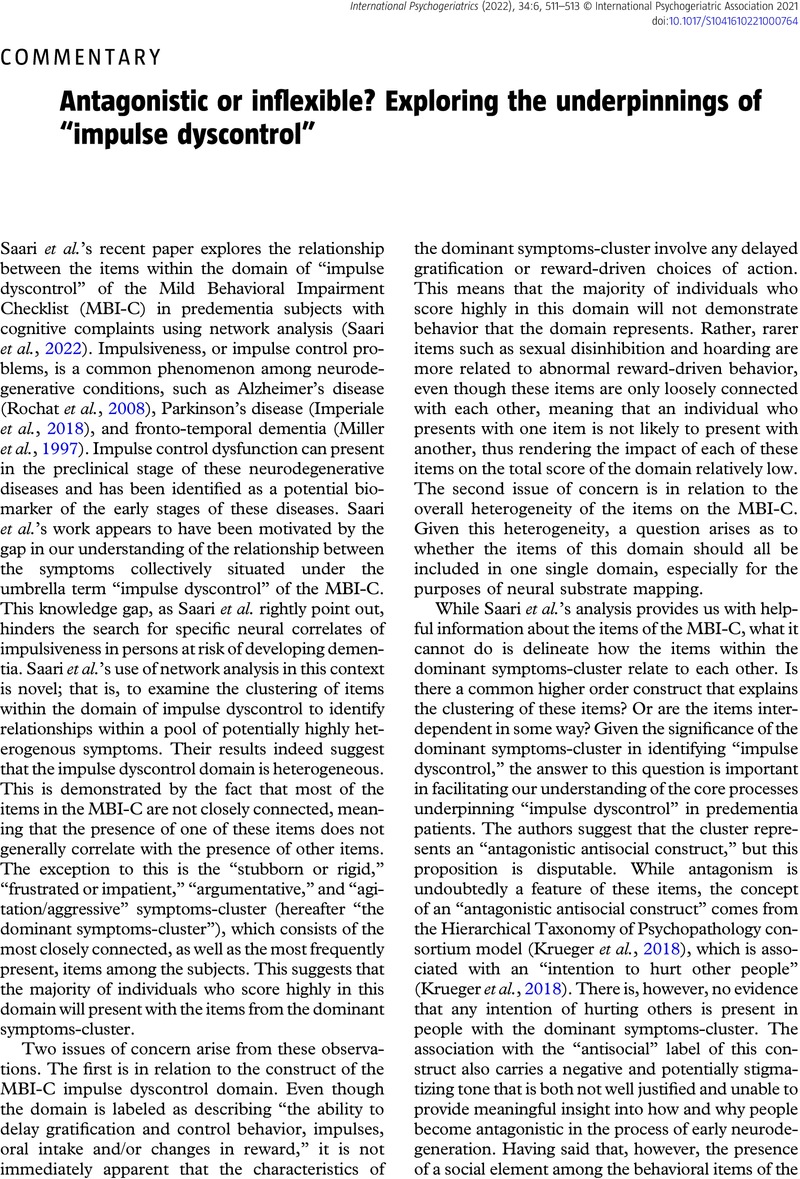No CrossRef data available.
Article contents
Antagonistic or inflexible? Exploring the underpinnings of “impulse dyscontrol”
Published online by Cambridge University Press: 21 May 2021
Abstract
An abstract is not available for this content so a preview has been provided. Please use the Get access link above for information on how to access this content.

- Type
- Commentary
- Information
- International Psychogeriatrics , Volume 34 , Special Issue 6: Issue Theme: New Studies of Mild Cognitive Impairment , June 2022 , pp. 511 - 513
- Copyright
- © International Psychogeriatric Association 2021
References
Adams, R. A., Huys, Q. J. and Roiser, J. P. (2016). Computational psychiatry: towards a mathematically informed understanding of mental illness. Journal of Neurology, Neurosurgery and Psychiatry, 87(1), 53–63. doi: 10.1136/jnnp-2015-310737.Google ScholarPubMed
Berwian, I. M. et al. (2020). Computational mechanisms of effort and reward decisions in patients with depression and their association with relapse after antidepressant discontinuation. JAMA Psychiatry, 77
(5), 513–522. doi: 10.1001/jamapsychiatry.2019.4971.CrossRefGoogle ScholarPubMed
Dajani, D. R. and Uddin, L. Q. (2015). Demystifying cognitive flexibility: implications for clinical and developmental neuroscience. Trends in Neuroscience, 38
(9), 571–578. doi: 10.1016/j.tins.2015.07.003.CrossRefGoogle ScholarPubMed
Godefroy, O. et al. (2010). Dysexecutive syndrome: diagnostic criteria and validation study. Annals of Neurology, 68
(6), 855–864. doi: 10.1002/ana.22117.CrossRefGoogle ScholarPubMed
Grattan, L. M. and Eslinger, P. J. (1989). Higher cognition and social behavior: changes in cognitive flexibility and empathy after cerebral lesions. Neuropsychology, 3
(3), 175–185. doi: 10.1037/h0091764.Google Scholar
Huys, Q. J., Maia, T. V. and Frank, M. J. (2016). Computational psychiatry as a bridge from neuroscience to clinical applications. Nature Neuroscience, 19
(3), 404–413. doi: 10.1038/nn.4238.CrossRefGoogle ScholarPubMed
Imperiale, F. et al. (2018). Brain structural and functional signatures of impulsive-compulsive behaviours in Parkinson’s disease. Molecular Psychiatry, 23
(2), 459–466. doi: 10.1038/mp.2017.18.CrossRefGoogle ScholarPubMed
Krueger, R. F. et al. (2018). Progress in achieving quantitative classification of psychopathology. World Psychiatry, 17
(3), 282–293. doi: 10.1002/wps.20566.CrossRefGoogle ScholarPubMed
Miles, S., Howlett, C. A., Berryman, C., Nedeljkovic, M., Moseley, G. L. and Phillipou, A. (2021). Considerations for using the Wisconsin Card Sorting Test to assess cognitive flexibility. Behavior Research Methods. doi: 10.3758/s13428-021-01551-3.CrossRefGoogle ScholarPubMed
Miller, B. L., Darby, A., Benson, D. F., Cummings, J. L. and Miller, M. H. (1997). Aggressive, socially disruptive and antisocial behaviour associated with fronto-temporal dementia. British Journal of Psychiatry, 170, 150–154. doi: 10.1192/bjp.170.2.150.CrossRefGoogle ScholarPubMed
Rochat, L., Delbeuck, X., Billieux, J., d’Acremont, M., Van der Linden, A. C. and Van der Linden, M. (2008). Assessing impulsivity changes in Alzheimer disease. Alzheimer Disease and Associated Disorders, 22
(3), 278–283. doi: 10.1097/WAD.0b013e318166d692.CrossRefGoogle ScholarPubMed
Saari, T., Smith, E. E. and Ismail, Z. (2022). Network analysis of impulse dyscontrol in mild cognitive impairment and subjective cognitive decline. International Psychogeriatrics, 34, 553–562. doi: 10.1017/S1041610220004123.Google Scholar
Simonsen, A. et al. (2021). Taking others into account: combining directly experienced and indirect information in schizophrenia. Brain. doi: 10.1093/brain/awab065.CrossRefGoogle Scholar
Sterzer, P. et al. (2018). The predictive coding account of psychosis. Biological Psychiatry, 84
(9), 634–643. doi: 10.1016/j.biopsych.2018.05.015.CrossRefGoogle Scholar




